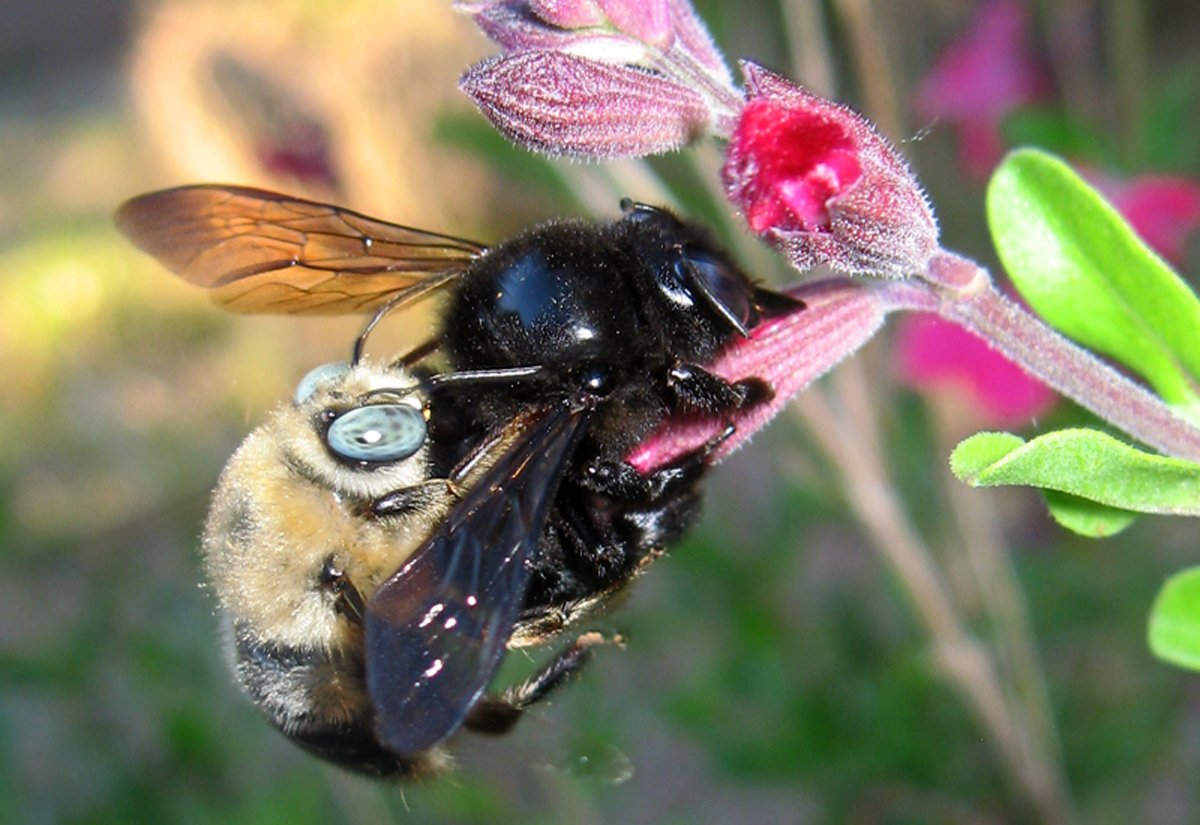It’s a bird! It’s a plane! It’s…a termite bee?!
While the idea of a termitic bee might conjure up Frankenstein’s monster–esque images of large mandibles, chomping jaws and a bright yellow-and-black body to match, know that you’re safe. No such creature actually exists (at least outside the realm of science fiction). But that hasn’t stopped the popular nickname from circulating around various media outlets.
Termite bee, wood-boring bee, wood bee, the big black bee…carpenter bees have about as many aliases as a career criminal! Given their tendency to drill perfectly neat holes into your home, it’s no wonder they are such a hot topic. But in order to keep things as accurate as possible, let’s set some facts straight.

Will the Real Carpenter Bee Please Stand Up?
All jokes aside, carpenter bees have an official and quite scientific-sounding name. Formally, these species of wood-boring bees go by the title genus Xylocopa1. Derived from the ancient Greek word “xylokopos”, this name can be roughly translated to “woodcutter” or, more cutely, “lumberjack2.” Not a bad name for a species of master craftsmen, eh?
Speaking of calling things by their right name, there is another species of pollinator that often gets an undeserved bad reputation – mason bees. While mason bees and carpenter bees don’t actually look very much alike (the latter is much larger and has that distinctive shiny black abdomen) their nesting habits can be quite similar. This can sometimes get the mason bee into some sticky situations – pun very much intended.

Sometimes referred to as gentle, tunnel-nesting bees, the mason bee is very similar to the carpenter in at least one respect: as solitary bees, they both like to lay their eggs in tunnels as opposed to a larger hive or honeycomb. However, unlike the carpenter bee, whose strong mandibles have no problem exercising their power in chomping through wood, mason bees prefer a more, shall we say, laissez-faire approach to life.

Rather than digging their own tunnels, mason bees prefer to simply take up residence in pre-existing ones and save themselves the hassle. This wouldn’t be an issue if it didn’t put them directly in the crosshairs of homeowners who are frantically trying to rid themselves of the wood-boring carpenter bees. After all, when you’re swinging that flyswatter around as fast as your good arm will allow, it can be hard to make that split-second differentiation between a carpenter bee and a mason bee.
This is most definitely a bad thing.
Mason bees are incredible pollinators, with some experts estimating that it only takes 250–300 females to pollinate an entire acre of apples or cherries3! So, next time you’re thinking about going on a swatting rampage, take a deep breath! We recommend first trying our Best Bee Brothers Wooden Corks to plug up all those pesky carpenter bee holes. We owe it to our crafty little pollinators to at least give them a fighting chance!
Do Carpenter Bees Sound like Termites?
They’re both wood boring, they’re both uninvited guests, and they both dig too many dang holes. So does a carpenter bee sound like a termite, and if not, how else can you tell them apart? Well, we’re not audio engineers, so we can’t speak to the exact level of decibel calibration needed to hear a termite at work (you’d likely need a stethoscope for that). But here is what we do know: termites cannot hear sound. That means when threatened or bothered, they have the nifty little habit of tapping their heads against the ground in order to communicate through vibrations4.
On the flip side, carpenter bees make noise – they are bees after all, and most bees, well, buzz! The truth of the matter, however, is that more often than not you will see the damage before you hear it. While it’s absolutely possible for carpenter bees to get inside your home and do their work, they tend to prefer untreated, unpainted wood, which is more often found on the outside of your home. Thus, in all likelihood, you’ll notice those perfectly round little holes in your siding, deck or porch before you are alerted by the buzzing of a busy carpenter bee.
Carpenter bees can be destructive and are certainly not the type of insect a homeowner wants hanging around their house. However, termites on the whole are even more destructive and can cause costly damage if left untreated. If you think you may have termites in your home, it’s best to call the extermination professionals and let them give you their two cents!
- Steve Buchman, “Carpenter Bees (Xylocopa spp.),” U.S. Forest Service, accessed March 12, 2021, https://www.fs.fed.us/wildflowers/pollinators/pollinator-of-the-month/carpenter_bees.shtml.
- Merriam-Webster.com Dictionary, s.v. “Xylocopa,” accessed March 14, 2021, https://www.merriam-webster.com/dictionary/Xylocopa.
- Judy Beaudette, “Attract Mason Bees – No Protective Gear Needed,” Ecological Landscape Alliance, October 17, 2017, https://www.ecolandscaping.org/03/landscaping-for-wildlife/beneficialspollinators/attract-mason-bees-no-protective-gear-needed/.
- Encyclopaedia Britannica Online, s.v., “Termite,” by Kumar Krishna, “, accessed March 12, 2021, https://www.britannica.com/animal/termite/Nutrition#ref39600.








Leave a comment
All comments are moderated before being published.
This site is protected by hCaptcha and the hCaptcha Privacy Policy and Terms of Service apply.